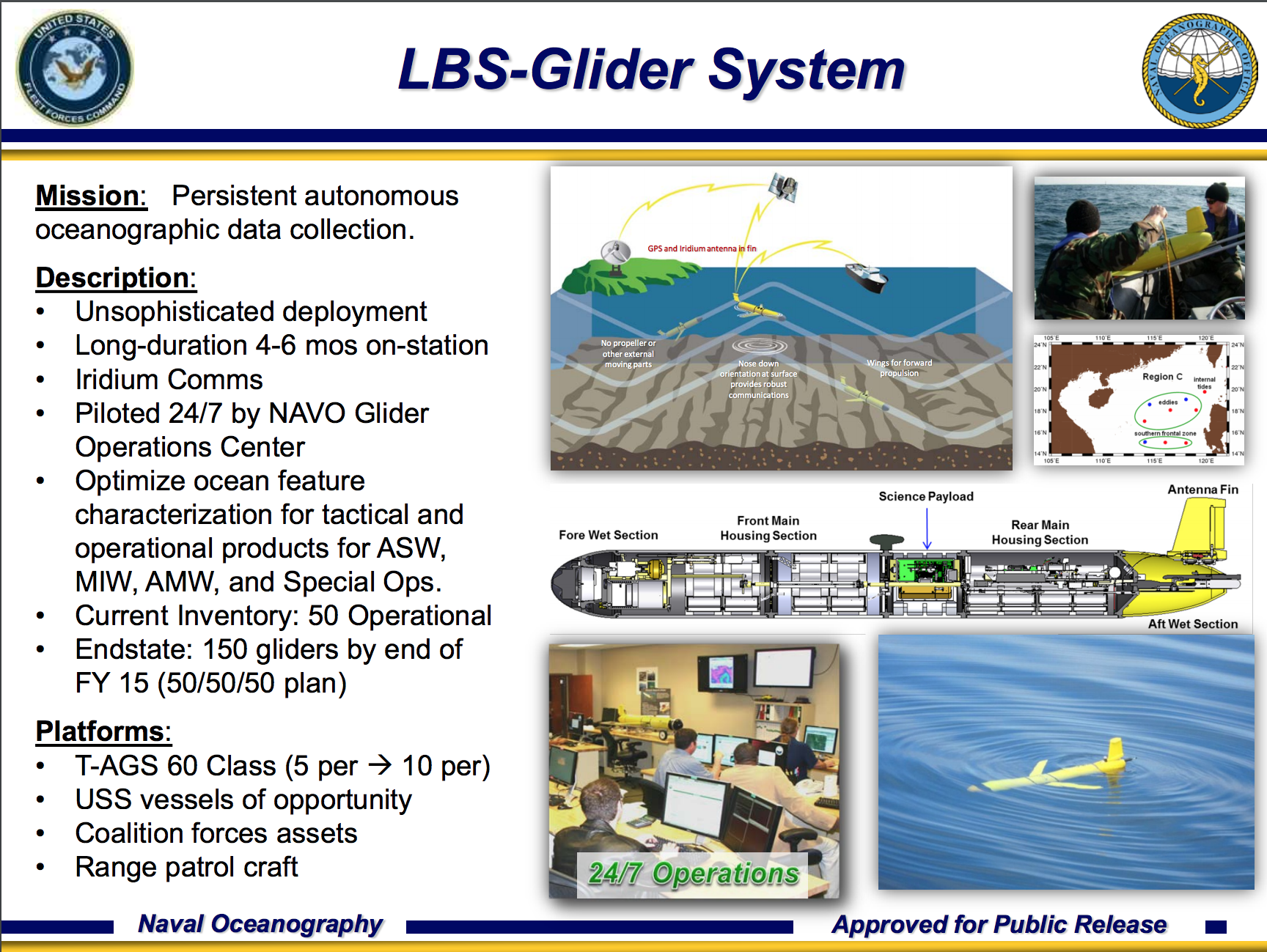Simple informative explanation of the military implications of what the USN and the PLAN are doing in instances like this USNS Bowditch incident with a glimpse of other issues surrounding the topic.
Q&A: China just seized a research robot from a U.S. Navy ship. What was it doing?
By David Malakoff
Dec. 16, 2016 , 1:45 PM
For ocean scientists who have worked with the U.S. military, today’s news that Chinese forces seized an oceanographic glider launched by an unarmed U.S. Navy research ship working in the South China Sea has a familiar ring. It’s not the first time that Chinese ships have confronted the USNS Bowditch or one of its five sister oceanographic ships, a little-known U.S. Navy fleet operated mostly by civilians that conducts mapping and ocean data collection cruises around the world. In 2001 and 2002, for instance, Chinese Navy frigates dogged the Bowditch as it worked in the Yellow Sea, leading to an exchange of diplomatic complaints.
In general, the Chinese object to the U.S. Navy conducting research activities within China’s exclusive economic zone (EEZ), which stretches some 320 kilometers off its coastline. But U.S. officials have long held that the United Nations Convention on the Law of the Sea specifically allows military ships to conduct research cruises within a nation’s EEZ (although civilian research cruises need to get permission from the host country).
To learn more about the work of the Bowditch and its sister ships, ScienceInsider chatted with now-retired Rear Admiral David Titley, who oversaw the U.S. Navy’s research fleet from 2007 to 2009 as commander of the Naval Meteorology and Oceanography Command. Titley is now director of the Center for Solutions to Weather and Climate Risk at Pennsylvania State University in State College. The interview has been edited for clarity and brevity.
Q: What do ships like the Bowditch do?
A: Well, these oceanographic survey ships are very rarely in the news, but they play a big part in what the Navy is doing, in a data-driven scientific way, to learn about our oceans. They do just what the name implies. The reason the Navy is interested in surveying the ocean worldwide is because it operates worldwide. So while the Navy has to play the away game, it needs and wants the home field advantage—it wants to know the terrain. And if you want to understand something you have to first measure it, and that’s what these ships are designed to do. They collect information about how deep the ocean is, the type of bottom, the currents, the temperature and salinity structure, and where the eddies are. All of that is essential to understanding the terrain and forecasting how it might change. They’ve been doing these missions in international waters for many, many decades.
Q: Are these regular Navy vessels?
A: These are Military Sealift Command vessels. In the Navy, we have what we call the gray hulls—your destroyers, aircraft carriers, and submarines—that have crews that are all active-duty military. Then there is the sealift command—the white hulls—that have civilian masters and mates, and the crews are often contractors. They also have a technical surveying crew that is usually mostly civilian oceanographers, hydrographers, and other technical personnel.
Q: What happens to the data these ships collect?
A: When the U.S. Navy works in another nation’s EEZ, you have to be careful about how you handle data, and what you do and do not release. Under the Law of the Sea, the position taken by the U.S. and many other nations is that the military can collect data within a country’s EEZ without the permission of that country, because it is a military survey. We can ask for permission, and we do at times, but we don’t have to. But those data then cannot be released to the general public, because that would make it a more civilian-type science expedition. And you don’t want another country to say: See, it’s not a military mission.
Q: China takes a different position on military research activities in the EEZ …
A: Yes, China does not like it. So, historically, what we have had occasionally is that when the Bowditch or [a similar ship] has been working in China’s EEZ, they have harassed our oceanographic survey ships. Now, I don’t know where the Bowditch exactly was working—the South China Sea is a huge area—or what its mission was. Clearly something has happened. But one of the first things you learn in the Navy is that the very first report is probably wrong. So I’m sure we’ll learn more.
Updated, 12/16/2016, 5:35p.m.: This story has been updated to remove a reference to the comparative sizes of the South China Sea and the contiguous United States.
Posted in: Asia/Pacific,
Oceanography,
Policy
DOI: 10.1126/science.aal0524


